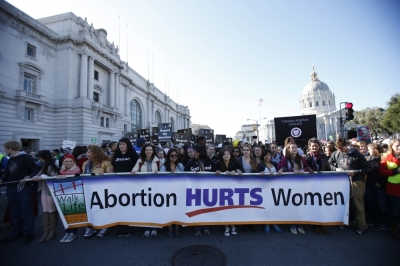New Report Misleads on the Health Risks of Abortion for Women

Earlier this month, the National Academies of Sciences, Engineering, and Medicine (NAS) released a report on the safety of abortion in the United States. It examines various methods used for abortion and concludes that abortion is safe and poses minimal health risks. The report also puts a negative spin on pro-life laws, arguing that many of them have no basis in medical research, and states that some abortion-specific regulations create barriers to safe health care. This report has received sympathetic coverage from a number of mainstream-media outlets including National Public Radio, the Washington Post, and the Los Angeles Times.
There is far less substance in this study than meets the eye. Indeed, a pro-abortion-rights bias is readily apparent in this report. The consultants on the National Academies report include both the abortionist Willie Parker and George Washington University law professor Sara Rosenbaum, a vocal supporter of Planned Parenthood. Two of the consultants are also affiliated with the Bixby Center for Global Reproductive Health, which supports legal abortion.
But no pro-life researchers or scholars served as authors or consultants on this report, and it was financed by a number of foundations, including the Packard Foundation and the Susan Thompson Buffett Foundation, which have given sizable grants to Planned Parenthood.
The report begins with an analysis of abortion trends. It notes correctly that the incidence of abortion is declining and that the U.S. abortion rate is 50 percent of what it was in 1980. But it gives pro-life efforts little credit for those trends. Instead, the report cites increased contraception use as a key reason for the decline in the abortion rate, even though unintended-pregnancy rates were largely stable between 1981 and 2008. It does acknowledge that pro-life laws may have played some role in the decline but fails to mention the significant decline in the percentage of unintended pregnancies that end in abortion.
Most of the report cherry-picks studies showing that abortion does not lead to either physical or psychological health problems. For instance, the 2011 British Journal of Psychology meta-study on the mental-health effects of abortion was not included. This meta-study is a survey of 22 published studies that combines data on 877,181 participants, presenting a body of peer-reviewed research showing that abortion increases the likelihood of depression, anxiety, alcoholism, drug use, and suicide.
Additionally, while the National Academies report mentions that there is evidence linking induced abortion to premature births, it downplays this risk. The report states that there is an increased risk of pre-term birth only among women who either had two or more aspiration abortions or conceived within six months after having an abortion. In actuality, 49 studies have demonstrated a statistically significant increase in premature births or low-birth-weight risk in women who had prior induced abortions.
Furthermore, ongoing debates about the safety of certain abortion procedures are ignored. For example, the National Academies report declares tele-med abortions—in which medical professionals supervise medical abortions via the Internet—safe based on two studies of Iowa women. But a 2015 study of abortion safety in California, based on comprehensive and reliable data from Medicaid billing records rather than surveys, found that medical abortions resulted in four times the complication rate of first-trimester surgical abortions. Given that chemical abortions are already riskier than early surgical abortions, it stands to reason that performing medical abortions without physician supervision only increases those risks.
The National Academies report also dismisses the abortion–breast cancer link, even though academic studies dating back to the 1950s show that abortion, particularly late-term, increases the risk of breast cancer. The Melbye et al. study, which appeared in the New England Journal of Medicine in 1997, is considered one of the methodologically strongest studies on the subject. Even though it is frequently cited by skeptics of the abortion–breast cancer link as evidence that induced abortion doesn't increase the risk of breast cancer, this study actually does provide strong statistical evidence that abortions performed after 18 weeks' gestation do increase breast-cancer risk. The National Academies report makes no mention of this.
Several media outlets have cited the report's conclusion that abortion safety is contingent on geography, pointing to limitations on the procedure in many states that supposedly reduce the safety of abortion. However, the report provides neither an analysis of abortion safety by state nor an analysis of how abortion restrictions affect the procedure's safety. Instead, the report cites research purporting to show that certain pro-life laws are correlated with increased travel distances to abortion facilities and delays for women seeking abortions.
These types of restrictions, though, are often good public policy and offer health benefits. For instance, a recent study of Utah's 72-hour waiting period found that, of 500 women seeking abortions, approximately 8 percent did not go through with the procedure. Women who chose to remain pregnant reported being less confident in their decision to seek an abortion. The study showed that a non-trivial percentage of women who seek abortions are conflicted about the decision, and waiting periods often result in some of those women choosing life.
Supporters of legal abortion have often argued that abortion procedures pose few health risks to women, but they rarely subject this claim to rigorous empirical scrutiny. Abortion-rights groups have shown almost no interest in improving abortion-reporting requirements to allow for better data on abortion-related injuries and deaths. These groups, along with their allies in the mainstream media, typically ignore the growing body of data from foreign academic journals demonstrating the dangers abortion can pose for women's health. This National Academies of Sciences, Engineering, and Medicine report is the latest attempt by the abortion industry to downplay the well-documented physical and psychological risks of abortion.
Michael J. New is an associate professor of Economics at Ave Maria University and an associate scholar at the Charlotte Lozier Institute.
Donna Harrison is a board-certified obstetrician and gynecologist, and executive director of the American Association of Pro-life Obstetricians and Gynecologists (AAPLOG).





















